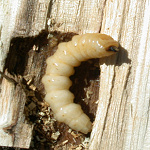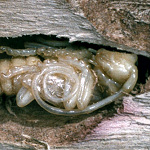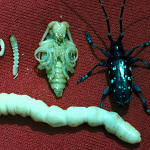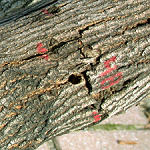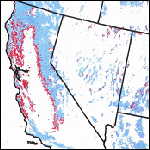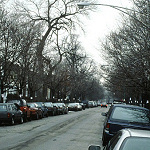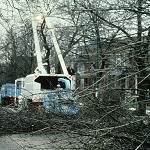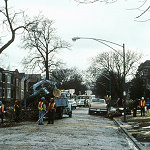 |
The Global Invasive Species Team |  |
|
Gallery of Pests:
Pests & pathogens not too widely spread Asian Longhorned Beetle - Anoplophora glabripennis Motschulsky - Faith Campbell - - August 2004; updated August 2008 - Photographs Click on the images below to view photographs. Complete photographic credits are given here.
Additional Resources: Additional pest notes, updates, etc.
Asian longhorned beetle
The Asian longhorned beetle has repeatedly entered North America as a hitchhiker in wood packaging (USDA APHIS & Forest Service, 2000), resulting in the establishment of numerous infestations in Chicago, New York, New Jersey, and Toronto. Several of these infestations were found by homeowners (Anonymous, 2004). At all of these sites, the Asian longhorned beetle is believed to have been present for years before its presence was noticed. These populations, as were the previous infestations, were probably brought over from China unintentionally inside solid wood packing materials. This beetle has been observed to feed on a variety of hardwood species, especially maples (Acer), but including poplars and aspens (Populus), horse chestnut (Aesculus hippocastanum), willow (Baccharis), birch (Betula), and elm (Ulmus) (USDA Forest Service, 2000). In an attempt to eradicate the Asian longhorned beetle, federal, state, and local officials destroyed more than 20,000 trees in New York and Chicago and spent more than $220 million (J. Dodd, pers. comm., 2004; and subsequent appropriations legislation). Even in cities, the Asian longhorned beetle has severe impacts. A study of seven cities in the northeast and north central regions (Baltimore, Boston, Chicago, Jersey City, New York City, Philadelphia, and Syracuse) found that half of their trees are vulnerable to destruction by the Asian longhorned beetle (Nowak et al., 2001). If it were introduced to one of these cities, and its spread were assisted by movement of infested wood and nursery stock, the Asian longhorned beetle could spread to all host trees growing in that city in as little as 6 years (Nowak et al., 2001). The estimated compensatory value of the trees killed would vary from $72 million in Jersey City to $2.2 billion in New York City. Nationwide, the Asian longhorned beetle could kill a third of urban trees, which have a compensatory value of $669 billion (Nowak et al., 2001). As of early spring 2008, officials believed that the Chicago-area outbreaks had been eradicated. The older outbreaks in the New York-New Jersey area had been greatly reduced; this good news was offset by the discovery of Asian longhorned beetles on Prall's and Staten islands in the harbor area between New York and New Jersey (USDA, 2007). Canada reported continued progress in trying to eradicate the Toronto outbreak (Stubbins, 2008). In August 2008, the Asian longhorned beetle was discovered in Worcester, Massachusetts (Associated Press, 2008) and re-discovered near Chicago (Shafer, 2008). These detections, especially the one in Massachusetts, have raised considerable alarm. Eradication programs have been hampered by inadequate funding. If the urban outbreaks of the Asian longhorned beetle are not eradicated, the beetle is likely to spread to North American forests. If it does, it has the potential to alter North American ecosystems across the continent. The impact would probably change dominant species composition and age structure in hardwood forests, particularly forests composed largely of maple and poplars reaching from New England to the Great Lakes. The majority of Canada's hardwoods are also susceptible (USDA APHIS & Forest Service, 2000). Once in rural areas, the Asian longhorned beetle would begin to affect a range of commercial interests. One obvious impact would be on timber production. Discounted monetary losses for timber resources around Chicago and New York would range from $1 to $10 million 30 years after introduction (USDA APHIS & Forest Service, 2000). Other industries likely to be affected include maple syrup production, nursery production, and "leaf peeper" tourism. In 2002, maple syrup production was valued at $38.4 million (USDA National Ag. Statistics Service, 2004). Nearly all U.S. production occurs in the northeast or upper midwest, near the New York City and Chicago infestations (USDA National Ag. Statistics Service, 2004). One million tourists intent on viewing autumn foliage generate $1 billion in revenue in New England each year (USDA APHIS, 1998). Maples are noted for producing some of most vivid colors that draw these tourists (USDA APHIS, 1998). Sources Anonymous. August 17, 2004. More Asian longhorned beetles found in Carteret, Rahway border. New Jersey Department of Agriculture press release. http://www.state.nj.us/agriculture/news/albpressconfPR.htm. Associate Press. 2008. Destructive invasive beetle found in Mass. Avril, T. August 20, 2004. Beetle damage spreading in north New Jersey. The Philadelphia Inquirer, p. B01. Dodd, John. February 2004. USDA APHIS Asian Longhorned Beetle Program, personal communication. Kridel, K. 2002. Asian longhorned beetle eradicated in Illinois, officials say Last sighting of tree-killing pest in the state was in 2002. Chicago Tribune. Nowak, D. J., J. E. Pasek, R. A. Sequeira, D. E. Crane, V. C. Mastro. 2001. Potential Effect of Anoplophora glabripennis (Coleoptera: Cermabycidae) on Urban Trees in the United States. Journal of Economic Entomology (94): 116-122. Shafer, E. 2008. USDA Secretary, personal communication, August 2008 Stubbins, G. 2008. Canadian Food Inspection Agency, pers. comm. August 2008. United States Department of Agriculture. Animal and Plant Health Inspection Service. 1998. Proposed Interim Rule on Solid Wood Packing Material from China. Environmental Assessment. September 1998. United States Department of Agriculture, Animal and Plant Health Inspection Service and Forest Service 2000. Pest Risk Assessment for Importation of Solid Wood Packing Materials into the United States. USDA APHIS and Forest Service. August 2000. United States Department of Agriculture, Forestry Service. 2000. The Asian Longhorned Beetle: A Threat to America's forests. September 24, 1998. United States Department of Agriculture. 2007. News Release. March 12, 2007. United States Department of Agriculture, National Ag. Statistics Service. February 2004. Crop Values 2003 Summary.
|
|||||||||||||||||
Updated August 2008 ©The Nature Conservancy, 2004 |
||||||||||||||||||
